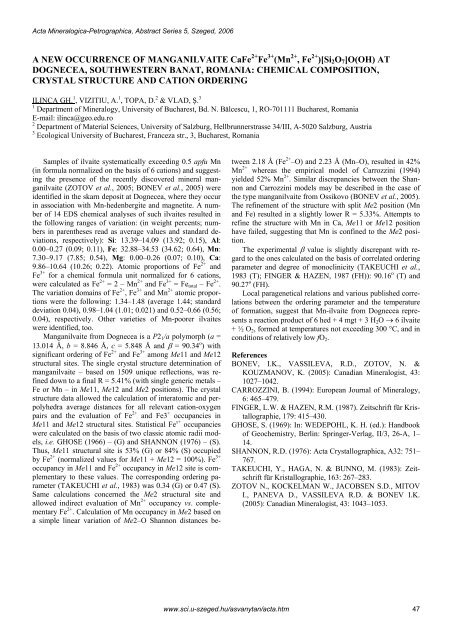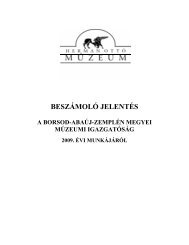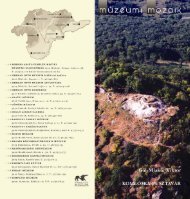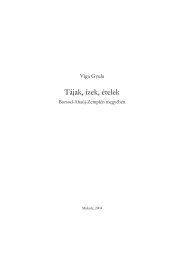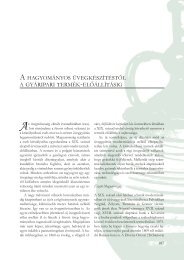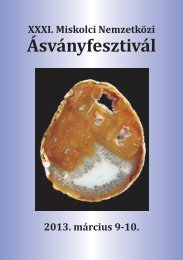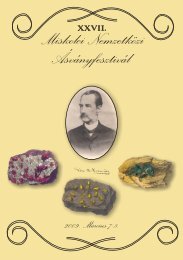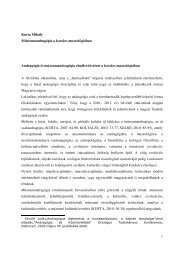Acta Mineralogica-Petrographica, Abstract Series 5, Szeged, 2006All members of the cuprobismutite family – i.e.,cuprobismutite, hodrushite, paděraite and the recently discoveredkupčíkite are represented in Romanian occurrences.Such episodes are confined to ore-deposits related to contactmetamorphicaureoles of Upper Cretaceous–Palaeocene calcalkalineigneous rocks in the so-called Banatitic Belt.Structural affinities of cuprobismutite members often reflectsin coherent intergrowths of two or three differentphases, such as hodrushite + kupčíkite ± paděraite (Fig. 6). Asimilar case of intergrowths between cuprobismutite andpaděraite from Ocna de Fier has recently been discussed byCIOBANU et al. (2004). Typical assemblages include bismuthinitederivatives, makovickyite-cupromakovickyite, emplectiteand various Bi tellurides.Fig. 6: Parallel intergrowths between hodrushite (h) and kupčíkite (Z) at Băiţa Bihor. Kupčíkite is preferentiallyaltered by emplectite (e) BSE image.Finally, not all sulphosalts may be considered rare, yetmany of the more common species reveal very peculiar aspectsof their crystal chemistry. It is the case of the bismuthinite–aikiniteseries (Bi 2 S 3 –CuPbBiS 3 ), a discrete family ofsub- and supercell structures which seemed a closed casesome ten years ago, but to which three more 4-fold and 5-foldsuperstructure members were added: salzburgiteCu 1.6 Pb 1.6 Bi 6.4 S 12 , paarite Cu 1.7 Pb 1.7 Bi 6.3 S 12 and emiliteCu 10.7 Pb 10.7 Bi 21.3 S 48 (BALIĆ-ZUNIĆ et al., 2002;MAKOVICKY et al., 2001; TOPA et al., 2005). Compositionalranges pointing to these three phases have already beenidentified in several occurrences from Romania, but they willbe in need of detailed crystal structure determinations.Cosalite – ideally Pb 2 Bi 2 S 5 – is another example of arather common sulphosalt species but with a complicatedhistory in what concerns substitutional mechanisms involvingAg and Cu, e.g. 2Pb ⇔ Bi(+Sb) + Ag; Bi(+Sb) ⇔ Pb + Cu;Pb + ⇔ Me + + Me + ; Pb + ⇔ Cu 2+ etc. Significantamounts of chemical and structural data are necessary toidentify the relevant trends for such replacement schemes.AcknowledgementsThe author wishes to thank Dr. DAN TOPA from theUniversity of Salzburg for the kindly provided support andmineralogical data, and Professor EMIL MAKOVICKY fromthe University of Copenhagen for the entire long-term supportand contribution to the topic discussed.ReferencesBALIĆ-ZUNIĆ, T., TOPA, D. & MAKOVICKY, E. (2002):Canadian Mineralogist, 40: 239–245.CHOE, W., LEE, S., O’CONNEL, P. & COVEY, A. (1997):Chemistry of Materials, 1997 (2): 2025–2030.CIOBANU, C. L., PR<strong>IN</strong>G, A. & COOK, N. J. (2004): MineralogicalMagazine, 68: 279–300.KARUP-MØLLER, S. & MAKOVICKY, E. (1979): Bulletinde Minéralogie, 102: 351–367.KARUP-MØLLER, S. & MAKOVICKY, E. (1992): NeuesJahrbuch für Mineralogie, Monatshefte, (12): 555–576.MAKOVICKY, E. (1989): Neues Jahrbuch für Mineralogie,Abhandlungen, 160: 269–297.MAKOVICKY, E., BALIĆ-ZUNIĆ, T. & TOPA, D. (2001):39: 1365–1376.MAKOVICKY, E., TOPA, D. & BALIĆ-ZUNIĆ, T. (2001):Canadian Mineralogist, 39: 1377–1382.MUMME, W.G. (1975): American Mineralogist, 60: 548–558.PR<strong>IN</strong>G, A. (1995): American Mineralogist, 80: 1166–1173.MAKOVICKY, E., TOPA, D. & BALIĆ-ZUNIĆ, T. (2001):Canadian Mineralogist, 39: 1377–1382.TOPA, D., MAKOVICKY, E. & BALIĆ-ZUNIĆ, T. (2005):Canadian Mineralogist, 43: 907–917.46www.sci.u-szeged.hu/asvanytan/acta.htm
Acta Mineralogica-Petrographica, Abstract Series 5, Szeged, 2006A NEW OCCURRENCE OF MANGANILVAITE CaFe 2+ Fe 3+ (Mn 2+ , Fe 2+ )[Si 2 O 7 ]O(OH) ATDOGNECEA, SOUTHWESTERN BANAT, ROMANIA: CHEMICAL COMPOSITION,CRYSTAL STRUCTURE AND CATION ORDER<strong>IN</strong>GIL<strong>IN</strong>CA GH. 1 , VIZITIU, A. 1 , TOPA, D. 2 & VLAD, Ş. 31 Department of Mineralogy, University of Bucharest, Bd. N. Bălcescu, 1, RO-701111 Bucharest, RomaniaE-mail: ilinca@geo.edu.ro2 Department of Material Sciences, University of Salzburg, Hellbrunnerstrasse 34/III, A-5020 Salzburg, Austria3 Ecological University of Bucharest, Franceza str., 3, Bucharest, RomaniaSamples of ilvaite systematically exceeding 0.5 apfu Mn(in formula normalized on the basis of 6 cations) and suggestingthe presence of the recently discovered mineral manganilvaite(ZOTOV et al., 2005; BONEV et al., 2005) wereidentified in the skarn deposit at Dognecea, where they occurin association with Mn-hedenbergite and magnetite. A numberof 14 EDS chemical analyses of such ilvaites resulted inthe following ranges of variation: (in weight percents; numbersin parentheses read as average values and standard deviations,respectively): Si: 13.39–14.09 (13.92; 0.15), Al:0.00–0.27 (0.09; 0.11), Fe: 32.88–34.53 (34.62; 0.64), Mn:7.30–9.17 (7.85; 0.54), Mg: 0.00–0.26 (0.07; 0.10), Ca:9.86–10.64 (10.26; 0.22). Atomic proportions of Fe 2+ andFe 3+ for a chemical formula unit normalized for 6 cations,were calculated as Fe 2+ = 2 – Mn 2+ and Fe 3+ = Fe total – Fe 2+ .The variation domains of Fe 2+ , Fe 3+ and Mn 2+ atomic proportionswere the following: 1.34–1.48 (average 1.44; standarddeviation 0.04), 0.98–1.04 (1.01; 0.021) and 0.52–0.66 (0.56;0.04), respectively. Other varieties of Mn-poorer ilvaiteswere identified, too.Manganilvaite from Dognecea is a P2 1 /a polymorph (a =13.014 Å, b = 8.846 Å, c = 5.848 Å and β = 90.34 o ) withsignificant ordering of Fe 2+ and Fe 3+ among Me11 and Me12structural sites. The single crystal structure determination ofmanganilvaite – based on 1509 unique reflections, was refineddown to a final R = 5.41% (with single generic metals –Fe or Mn – in Me11, Me12 and Me2 positions). The crystalstructure data allowed the calculation of interatomic and perpolyhedraaverage distances for all relevant cation-oxygenpairs and the evaluation of Fe 2+ and Fe3 + occupancies inMe11 and Me12 structural sites. Statistical Fe x+ occupancieswere calculated on the basis of two classic atomic radii models,i.e. GHOSE (1966) – (G) and SHANNON (1976) – (S).Thus, Me11 structural site is 53% (G) or 84% (S) occupiedby Fe 2+ (normalized values for Me11 + Me12 = 100%). Fe 3+occupancy in Me11 and Fe 2+ occupancy in Me12 site is complementaryto these values. The corresponding ordering parameter(TAKEUCHI et al., 1983) was 0.34 (G) or 0.47 (S).Same calculations concerned the Me2 structural site andallowed indirect evaluation of Mn 2+ occupancy vs. complementaryFe 2+ . Calculation of Mn occupancy in Me2 based ona simple linear variation of Me2–O Shannon distances between2.18 Å (Fe 2+ –O) and 2.23 Å (Mn–O), resulted in 42%Mn 2+ whereas the empirical model of Carrozzini (1994)yielded 52% Mn 2+ . Similar discrepancies between the Shannonand Carrozzini models may be described in the case ofthe type manganilvaite from Ossikovo (BONEV et al., 2005).The refinement of the structure with split Me2 position (Mnand Fe) resulted in a slightly lower R = 5.33%. Attempts torefine the structure with Mn in Ca, Me11 or Me12 positionhave failed, suggesting that Mn is confined to the Me2 position.The experimental β value is slightly discrepant with regardto the ones calculated on the basis of correlated orderingparameter and degree of monoclinicity (TAKEUCHI et al.,1983 (T); F<strong>IN</strong>GER & HAZEN, 1987 (FH)): 90.16 o (T) and90.27 o (FH).Local paragenetical relations and various published correlationsbetween the ordering parameter and the temperatureof formation, suggest that Mn-ilvaite from Dognecea representsa reaction product of 6 hed + 4 mgt + 3 H 2 O → 6 ilvaite+ ½ O 2 , formed at temperatures not exceeding 300 °C, and inconditions of relatively low fO 2 .ReferencesBONEV, I.K., VASSILEVA, R.D., ZOTOV, N. &KOUZMANOV, K. (2005): Canadian Mineralogist, 43:1027–1042.CARROZZ<strong>IN</strong>I, B. (1994): European Journal of Mineralogy,6: 465–479.F<strong>IN</strong>GER, L.W. & HAZEN, R.M. (1987). Zeitschrift für Kristallographie,179: 415–430.GHOSE, S. (1969): In: WEDEPOHL, K. H. (ed.): Handbookof Geochemistry, Berlin: Springer-Verlag, II/3, 26-A, 1–14.SHANNON, R.D. (1976): Acta Crystallographica, A32: 751–767.TAKEUCHI, Y., HAGA, N. & BUNNO, M. (1983): Zeitschriftfür Kristallographie, 163: 267–283.ZOTOV N., KOCKELMAN W., JACOBSEN S.D., MITOVI., PANEVA D., VASSILEVA R.D. & BONEV I.K.(2005): Canadian Mineralogist, 43: 1043–1053.www.sci.u-szeged.hu/asvanytan/acta.htm 47
- Page 1: MSCC33 rd MINERAL SCIENCES IN THE C
- Page 5 and 6: Acta Mineralogica-Petrographica, Ab
- Page 7 and 8: Acta Mineralogica-Petrographica, Ab
- Page 9 and 10: Acta Mineralogica-Petrographica, Ab
- Page 11 and 12: Acta Mineralogica-Petrographica, Ab
- Page 13 and 14: Acta Mineralogica-Petrographica, Ab
- Page 15 and 16: Acta Mineralogica-Petrographica, Ab
- Page 17 and 18: Acta Mineralogica-Petrographica, Ab
- Page 19 and 20: Acta Mineralogica-Petrographica, Ab
- Page 21 and 22: Acta Mineralogica-Petrographica, Ab
- Page 23 and 24: Acta Mineralogica-Petrographica, Ab
- Page 25 and 26: Acta Mineralogica-Petrographica, Ab
- Page 27 and 28: Acta Mineralogica-Petrographica, Ab
- Page 29 and 30: Acta Mineralogica-Petrographica, Ab
- Page 31 and 32: Acta Mineralogica-Petrographica, Ab
- Page 33 and 34: Acta Mineralogica-Petrographica, Ab
- Page 35 and 36: Acta Mineralogica-Petrographica, Ab
- Page 37 and 38: Acta Mineralogica-Petrographica, Ab
- Page 39 and 40: Acta Mineralogica-Petrographica, Ab
- Page 41 and 42: Acta Mineralogica-Petrographica, Ab
- Page 43 and 44: Acta Mineralogica-Petrographica, Ab
- Page 45: Acta Mineralogica-Petrographica, Ab
- Page 49 and 50: Acta Mineralogica-Petrographica, Ab
- Page 51 and 52: Acta Mineralogica-Petrographica, Ab
- Page 53 and 54: Acta Mineralogica-Petrographica, Ab
- Page 55 and 56: Acta Mineralogica-Petrographica, Ab
- Page 57 and 58: Acta Mineralogica-Petrographica, Ab
- Page 59 and 60: Acta Mineralogica-Petrographica, Ab
- Page 61 and 62: Acta Mineralogica-Petrographica, Ab
- Page 63 and 64: Acta Mineralogica-Petrographica, Ab
- Page 65 and 66: Acta Mineralogica-Petrographica, Ab
- Page 67 and 68: Acta Mineralogica-Petrographica, Ab
- Page 69 and 70: Acta Mineralogica-Petrographica, Ab
- Page 71 and 72: Acta Mineralogica-Petrographica, Ab
- Page 73 and 74: Acta Mineralogica-Petrographica, Ab
- Page 75 and 76: Acta Mineralogica-Petrographica, Ab
- Page 77 and 78: Acta Mineralogica-Petrographica, Ab
- Page 79 and 80: Acta Mineralogica-Petrographica, Ab
- Page 81 and 82: Acta Mineralogica-Petrographica, Ab
- Page 83 and 84: Acta Mineralogica-Petrographica, Ab
- Page 85 and 86: Acta Mineralogica-Petrographica, Ab
- Page 87 and 88: Acta Mineralogica-Petrographica, Ab
- Page 89 and 90: Acta Mineralogica-Petrographica, Ab
- Page 91 and 92: Acta Mineralogica-Petrographica, Ab
- Page 93 and 94: Acta Mineralogica-Petrographica, Ab
- Page 95 and 96: Acta Mineralogica-Petrographica, Ab
- Page 97 and 98:
Acta Mineralogica-Petrographica, Ab
- Page 99 and 100:
Acta Mineralogica-Petrographica, Ab
- Page 101 and 102:
Acta Mineralogica-Petrographica, Ab
- Page 103 and 104:
Acta Mineralogica-Petrographica, Ab
- Page 105 and 106:
Acta Mineralogica-Petrographica, Ab
- Page 107 and 108:
Acta Mineralogica-Petrographica, Ab
- Page 109 and 110:
Acta Mineralogica-Petrographica, Ab
- Page 111 and 112:
Acta Mineralogica-Petrographica, Ab
- Page 113 and 114:
Acta Mineralogica-Petrographica, Ab
- Page 115 and 116:
Acta Mineralogica-Petrographica, Ab
- Page 117 and 118:
Acta Mineralogica-Petrographica, Ab
- Page 119 and 120:
Acta Mineralogica-Petrographica, Ab
- Page 121 and 122:
Acta Mineralogica-Petrographica, Ab
- Page 123 and 124:
Acta Mineralogica-Petrographica, Ab
- Page 125 and 126:
Acta Mineralogica-Petrographica, Ab
- Page 127 and 128:
Acta Mineralogica-Petrographica, Ab
- Page 129 and 130:
Acta Mineralogica-Petrographica, Ab
- Page 131 and 132:
Acta Mineralogica-Petrographica, Ab
- Page 133 and 134:
Acta Mineralogica-Petrographica, Ab


